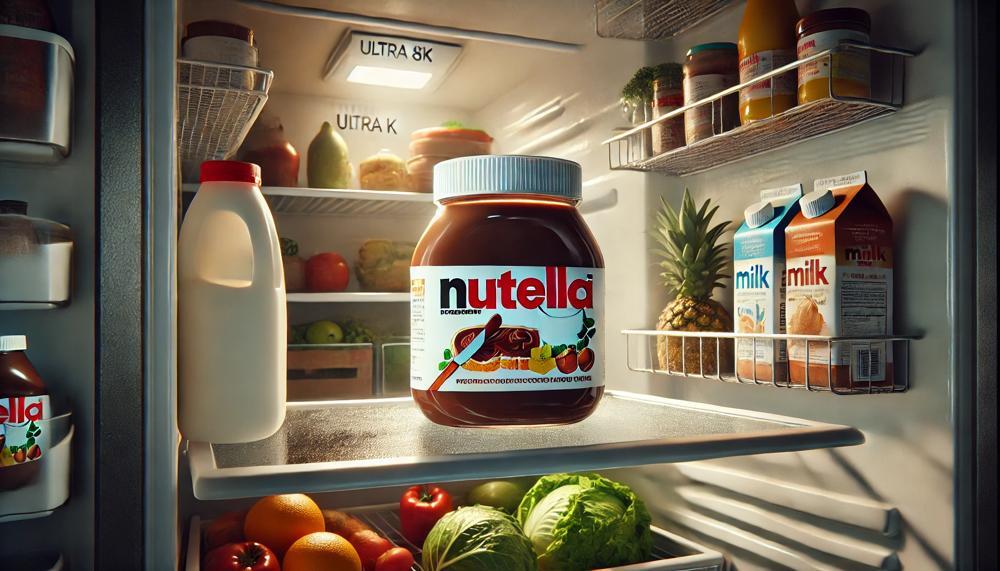Contents
No, Nutella Should Not Be Refrigerated
Wondering whether to stick that jar of Nutella in the fridge? The simple answer is no. Nutella doesn’t need refrigeration to maintain its quality and flavor. Here’s why:
Nutella is designed to stay at its best when stored at room temperature, specifically between 64°F and 72°F. Ferrero, the maker of Nutella, advises against refrigeration because it can make the spread too firm and challenging to spread on your favorite toast or pastry.
Key Takeaways:
- Optimal Storage: Keep Nutella at room temperature (64°F to 72°F) for the best consistency.
- Avoid Refrigeration: Cold storage can harden Nutella, making it difficult to spread and possibly shortening its shelf life.
- Ingredients Matter: Nutella contains sugar and palm oil, which help preserve its quality without the need for refrigeration.
- Proper Storage Tips: Store Nutella in a cool, dry place, away from direct sunlight and heat sources to maintain its texture and flavor.
- Sealed for Freshness: Once opened, keep the jar tightly sealed and stored at room temperature to prevent moisture and mold.
Following these tips ensures that every scoop of Nutella remains smooth, spreadable, and delicious.
What happens if Nutella is refrigerated?
Refrigerating Nutella is generally not advised as it leads to several undesirable changes in its texture and flavour. Below are the key effects of refrigerating Nutella:
- Hard and Difficult to Spread: Nutella becomes firm and loses its creamy consistency when refrigerated, making it hard to spread on bread or other items.
- Condensation Issues: Moisture can form inside the jar due to condensation, potentially leading to spoilage. This moisture can cause the spread to become less appealing and possibly unsafe to consume.
- Altered Flavor and Texture: Refrigeration can impact the flavour profile and texture of Nutella, diminishing the rich and smooth experience it typically offers when stored at room temperature.
- Manufacturer’s Advice: The label on Nutella jars specifically advises against refrigeration. Ferrero, the manufacturer, recommends storing Nutella at room temperature between 64°F and 72°F to maintain its optimal spreadable consistency and quality.
For optimal storage:
- Room Temperature: Keep Nutella in a cool, dry place away from direct sunlight and heat sources.
- Sealed Tight: Ensure the jar is tightly sealed after each use to prevent moisture intrusion and contamination.
- Clean Utensils: Always use clean utensils to avoid introducing bacteria and extending its shelf life.
If Nutella does get refrigerated and becomes too stiff to use, it can be softened by microwaving it for a few seconds, but this is not the best practice for preserving its quality.
Why can’t you store Nutella in the fridge?
Storing Nutella in the fridge is a bad idea due to several key reasons.
- Texture Change: Refrigeration significantly alters the texture of Nutella, making it hard and difficult to spread. Nutella’s creamy consistency is one of its main appeals, and chilling it in the fridge turns it into a solid, unspreadable mass. Imagine trying to spread a rock on your morning toast—not exactly a pleasant experience.
- Condensation Issues: When you store Nutella in the fridge, condensation can form inside the jar due to the temperature difference. This moisture can lead to the growth of mold, which not only ruins the Nutella but also poses health risks. Moldy Nutella is definitely something you want to avoid.
- Flavor Deterioration: The cold temperature of the fridge can affect the flavor profile of Nutella. It can lose its rich, chocolaty taste, making your favourite spread less enjoyable. Room temperature storage preserves the delicious taste that Nutella lovers crave.
- Manufacturer’s Recommendation: Ferrero, the maker of Nutella, advises against refrigeration. They recommend storing Nutella at room temperature to maintain its optimal texture, taste, and overall quality. Following the manufacturer’s guidelines ensures you enjoy Nutella at its best.
How long is Nutella good for once opened?
Nutella is typically good for up to 12 months once opened. Here are some important details to consider:
Storage Conditions:
- Always ensure the lid is tightly sealed when the jar is not in use.
- Use clean utensils to scoop out Nutella to prevent bacterial contamination.
Signs of Spoilage:
- Rancidity: Check for a sour or off smell, which indicates rancid oils. Although rancid Nutella might still be safe to eat, its taste will be unpleasant.
- Texture and Appearance: Nutella should maintain a creamy texture. If you notice any separation, graininess, or mold, discard it immediately.
- Taste: If the Nutella tastes off or unusual, it’s best to err on the side of caution and throw it away.
Shelf Life of Unopened Nutella:
- Unopened jars can remain good for up to 6 months past the best before date, provided they are stored in a cool, dry place away from direct sunlight.
Is Beef Jerky Keto Friendly?
The short answer is yes, beef jerky can be keto-friendly. However, you need to be selective about the type and brand of jerky to ensure it fits within keto guidelines. Here’s a detailed explanation to help you navigate your choices.
Key Points to Consider
Ingredients and Nutritional Content
- Sugar Content: Many commercial beef jerky products contain added sugars, which can kick you out of ketosis. Look for options labeled “zero sugar” or “no added sugar.”
- Protein and Fat: While protein is crucial on a keto diet, an ideal keto snack should also have a higher fat content. Traditional beef jerky tends to be high in protein but low in fat. Some brands offer keto-specific jerky that balances this better.
Popular Keto-Friendly Brands
- Jack Link’s Zero Sugar Original Beef Jerky: This brand is well-known for its keto-friendly options, with zero added sugars and a good protein profile.
Making Your Own Jerky
- Control Ingredients: By making your own beef jerky, you can ensure there are no hidden sugars or carbs. Use cuts of beef with a higher fat content and season with keto-friendly spices.
- Cost-Effective: Homemade jerky can be more economical and allows for customization to suit your taste and dietary needs.
Nutritional Table

Here’s a comparison table to help you select the best options:
| Brand/Type | Sugar Content | Protein Content |
| Jack Link’s Zero Sugar Original Beef Jerky | 0g | 15g per serving |
| Generic Store Brand Jerky | 5-8g | 10-12g per serving |
| Homemade Beef Jerky | 0g | Varies based on recipe |
Tips for Choosing Keto-Friendly Jerky
- Read Labels Carefully: Always check the nutritional information and ingredients list.
- Avoid High-Carb Additives: Stay away from jerky that includes sugar, honey, or high-fructose corn syrup.
- Look for Keto Certifications: Some products are certified keto-friendly, which can make your choice easier.
Chicken Tastes Sour: Is It Bad?
Yes, if your chicken tastes sour, it is likely spoiled and not safe to eat. The sour taste often results from bacterial growth, which produces off-putting odours and flavours. Consuming such chicken can lead to digestive problems like vomiting, diarrhea, and an upset stomach due to harmful bacteria.
| Reason | Description | Action |
| Bacterial Growth | Pathogens produce sour taste and funky smell | Discard the chicken immediately |
| Intentional Acidic Ingredients | If vinegar or lemon was added | Safe to eat if properly cooked |
| Unintentional Spoilage | Sour taste without added acids | Do not consume to avoid health risks |
Are Beef Sticks Safe During Pregnancy?
Generally, beef sticks like Slim Jims are not considered entirely safe during pregnancy. The main concern revolves around the risk of foodborne illnesses and the high levels of sodium and preservatives often found in these products.
Foodborne Illness Risks:
- Slim Jims and similar beef sticks are processed meat products. They can harbor bacteria like Listeria and Salmonella, which pose a significant risk during pregnancy. Consuming undercooked or improperly processed meats can lead to severe infections, potentially harming both mother and baby.
- According to the CDC, pregnant women are more susceptible to foodborne illnesses due to a weakened immune system.
High Sodium Content:
- Beef sticks like Slim Jims are often high in sodium. Excessive sodium intake can lead to increased blood pressure and other complications during pregnancy. It’s advisable to limit foods high in sodium to maintain optimal health.
Preservatives:
- Many commercial beef sticks contain nitrates and nitrites. These preservatives are used to extend shelf life and enhance flavor, but they can be harmful in large amounts, potentially increasing the risk of certain cancers and other health issues.
Conclusion
Keeping Nutella in the fridge is a big no-no. Nutella is best enjoyed when stored at room temperature, ideally between 64°F and 72°F. Ferrero, the brand behind Nutella, strongly advises against refrigeration because it significantly alters the texture and flavor of the spread.
Refrigeration makes Nutella hard and difficult to spread, which defeats the purpose of its creamy consistency. Moreover, the cold temperature can cause condensation inside the jar, potentially leading to spoilage and mold. The rich, chocolaty flavor we love in Nutella also gets compromised when it’s chilled.
For the best Nutella experience, store it in a cool, dry place away from direct sunlight and heat sources. Keep the jar tightly sealed after each use to maintain its freshness and prevent moisture from getting in. If your Nutella does get a bit too firm, a quick zap in the microwave can help, but it’s better to avoid this situation altogether by proper storage.
In summary, to enjoy every scoop of Nutella smooth and spreadable, just keep it at room temperature, tightly sealed, and away from heat and light.




